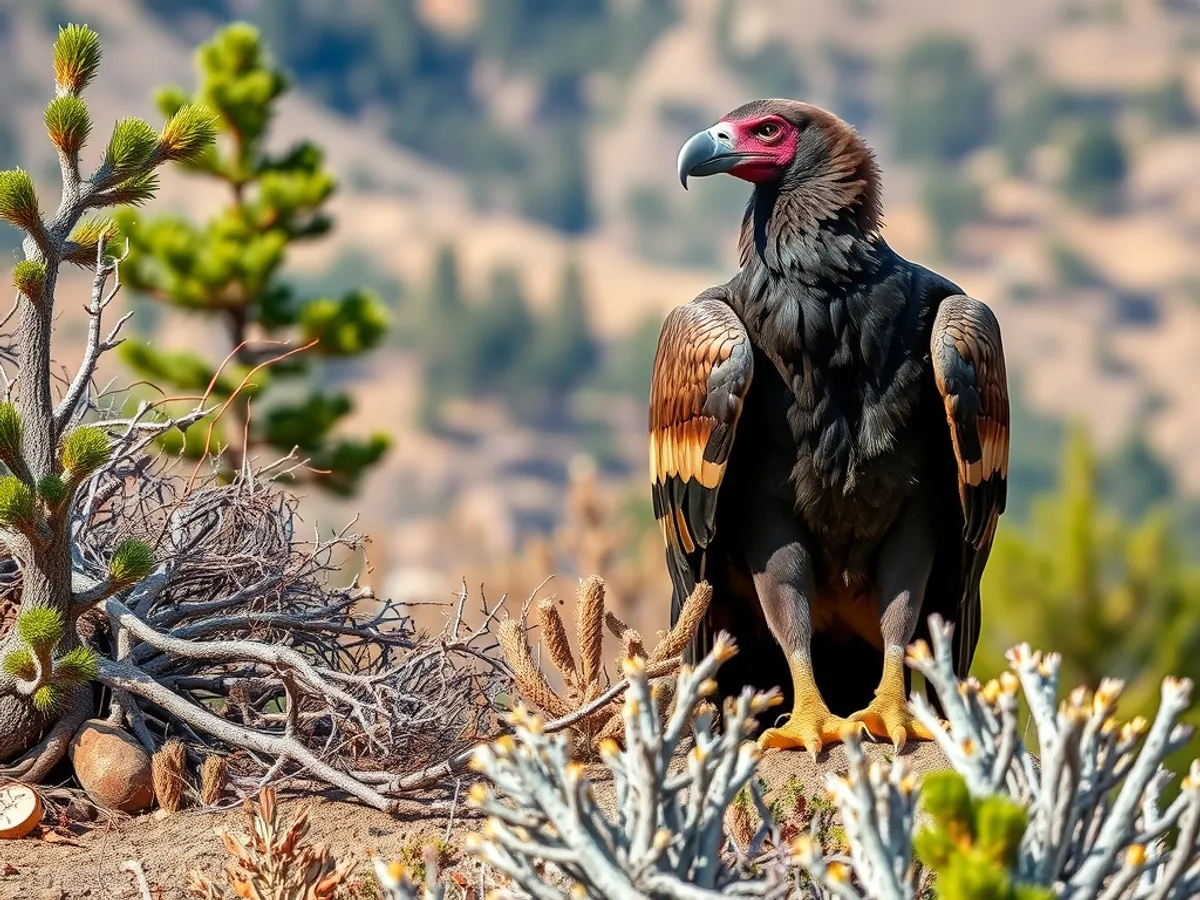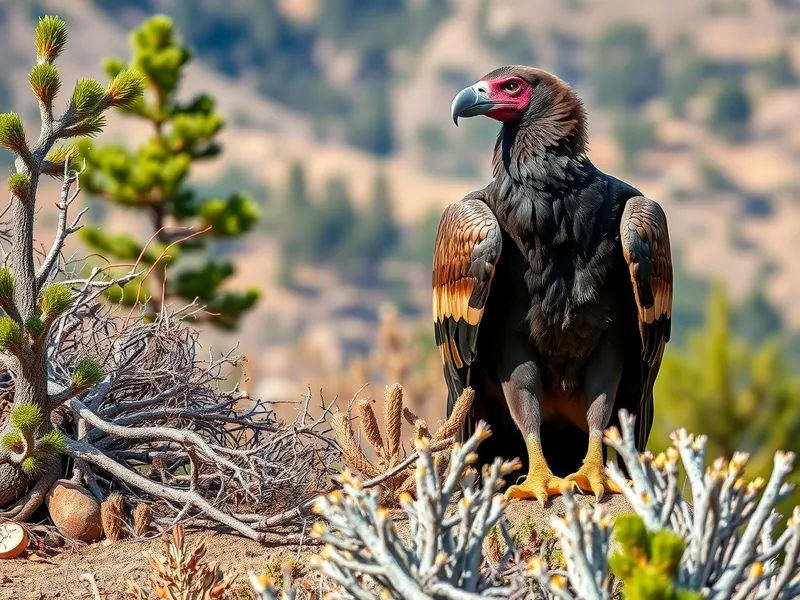
California Condor
Gymnogyps californianus

Meet the California Condor
The California Condor is the largest North American land bird, boasting an impressive wingspan of up to 3 meters (nearly 10 feet). This critically endangered vulture is known for its striking black plumage with white patches under its wings and a bald head that changes color with emotional state. California Condors are scavengers, soaring over canyons, mountains, and forests in search of carrion. Once on the brink of extinction, intensive conservation efforts have slowly increased their population, though they remain one of the rarest birds in the world.
Classification
Bird
Habitat
Rocky shrubland, coniferous forests, and mountainous regions
Diet
Carnivore (Scavenger)
Lifespan
40-60 years
Conservation
Critically Endangered
Weight
8-14 kg (17-31 lbs)
📖Fascinating Facts
Massive Wingspan
California Condors have the largest wingspan of any North American bird, reaching up to 3 meters (nearly 10 feet) from tip to tip.
Specialized Scavenger
They feed exclusively on carrion, using their sharp beaks to tear into the toughest hides and bones.
Conservation Icon
The California Condor was the focus of one of the most intensive endangered species recovery programs in history, involving captive breeding and reintroduction to the wild.
📋Detailed Description
The California Condor (Gymnogyps californianus) is a massive New World vulture, distinguished by its impressive wingspan of 2.7 to 3 meters (8.9–9.8 feet), making it the largest land bird in North America. Adults typically weigh between 8 and 14 kilograms (18–31 lbs), with males and females similar in size, though males are slightly heavier. Their plumage is predominantly black, accented by striking white triangular patches on the underside of the wings, which are visible in flight. The head and neck are largely bare of feathers, displaying skin that ranges from yellowish to reddish-orange, with coloration intensifying during social interactions or emotional arousal. Condors possess strong, hooked beaks adapted for tearing tough hides and muscle from large carcasses, and their feet are more suited for walking than grasping, unlike many raptors. Their keen eyesight allows them to spot carrion from great heights. California Condors are highly social, often roosting and feeding in groups, and exhibit complex social hierarchies. They are long-lived birds, with lifespans exceeding 60 years in the wild. Their slow reproductive rate and extensive parental investment are notable, with pairs typically raising only one chick every one to two years. The species is adapted for soaring flight, utilizing thermals to cover vast distances with minimal energy expenditure, an essential trait for locating widely dispersed food sources in rugged terrain.
💡 Did you know?
Every wild California Condor alive today is descended from just 27 individuals that were captured in the 1980s for a last-ditch captive breeding program.
🔬Research & Sources
Wikipedia Summary
The California condor is a New World vulture and the largest North American land bird. It became extinct in the wild in 1987 when all remaining wild individuals were captured, but has since been reintroduced to northern Arizona and southern Utah, the coastal mountains of California, and northern Baja California in Mexico. It is the only surviving member of the genus Gymnogyps, although four extinct members of the genus are also known. The species is listed by the International Union for the Conservation of Nature as Critically Endangered, and similarly considered Critically Imperiled by NatureServe.
Last Modified: 6/3/2025
🎭Behavior & Social Structure
California Condors are obligate scavengers, feeding exclusively on carrion from large mammals such as deer, cattle, and marine mammals. They do not hunt live prey. Condors rely on soaring flight, often traveling over 250 kilometers (155 miles) in a single day in search of food. They use communal roosts and display strong site fidelity to favored perching and nesting locations. Social interactions are complex, with dominance hierarchies established at feeding sites through ritualized displays, including wing-spreading, hissing, and bill snapping. Bathing and sunning are common behaviors, with individuals often observed spreading their wings to thermoregulate or dry plumage. Daily routines are dictated by thermals, with most activity occurring during the warmer parts of the day. Condors are generally silent but may produce low grunts or hisses during interactions.
👶Reproduction & Life Cycle
California Condors form long-term monogamous pairs, often remaining together for many years. Breeding typically occurs every other year, with courtship beginning in late winter or early spring. Pairs engage in elaborate courtship displays, including mutual preening and aerial acrobatics. Nests are usually located in caves, crevices, or on cliff ledges in remote, rugged terrain. The female lays a single, pale blue-green egg, which both parents incubate for approximately 53–60 days. If a clutch is lost early, pairs may lay a replacement egg, a phenomenon known as double-clutching. After hatching, the chick is altricial and dependent on parental care for up to 12 months, though fledging typically occurs at 5–6 months. Both parents feed the chick by regurgitation. Juveniles remain with their parents for several months post-fledging, learning essential survival skills.
🛡️Adaptations & Survival
California Condors are highly specialized for a scavenging lifestyle. Their large wings and low wing loading enable efficient soaring over vast distances, minimizing energy expenditure. The bald head and neck are adaptations for hygiene, reducing feather fouling when feeding inside carcasses. Their strong, hooked beaks allow them to tear through tough hides, while their relatively weak feet are adapted for walking and stability rather than killing prey. Condors have an exceptionally keen sense of sight, critical for locating food. They possess a highly acidic digestive system capable of neutralizing pathogens found in decaying flesh. Social behaviors, such as communal roosting and feeding, facilitate information transfer about food sources and reinforce social bonds.
📚Research Sources
🎨Cultural Significance
The California Condor holds profound cultural significance for many Indigenous peoples of California and the American Southwest, often symbolizing power, renewal, and the spirit world. In Chumash and other Native American traditions, the condor features prominently in creation myths and is revered as a messenger or sacred animal. The species has also become a modern conservation icon, representing both the fragility and resilience of North America's natural heritage. Its dramatic decline and ongoing recovery have inspired public awareness campaigns and legislative action for wildlife protection.
🔬Recent Research & Discoveries
Recent research has focused on the genetic health of the population, with whole-genome sequencing revealing low genetic diversity and inbreeding concerns, underscoring the importance of careful management of the captive breeding program. Studies on lead exposure have led to policy changes, including bans on lead ammunition in condor habitats. Biotelemetry and GPS tracking have provided insights into condor movement ecology, habitat use, and foraging behavior, informing reintroduction and management strategies. Ongoing research is investigating the effects of environmental contaminants, disease susceptibility (notably West Nile virus), and the potential for reestablishing self-sustaining populations without intensive human intervention.
🎥Wildlife Videos

How the Condor Is Reclaiming Its Place in American Wilderness
This is the story of North America's airborne giant. The California Condor has lived through one of the most drastic situations ever ...
Mossy Earth

The California Condor: A Majestic Bird on the Brink of Extinction
Discover the incredible story of the California condor, one of North America's most majestic birds, in our latest video, "The ...
Animal Profiles

The Condor's Shadow
The Condor's Shadow profiles a bold and feisty condor named Pitahsi and a larger-than-life biologist with the U.S. Fish & Wildlife ...
Good Eye Films
![[Official Trailer] Condor Canyon, a feature-length documentary film by Ventana Wildlife Society](https://i.ytimg.com/vi/dgCVAA-NNig/hq720.jpg?sqp=-oaymwEcCOgCEMoBSFXyq4qpAw4IARUAAIhCGAFwAcABBg==&rs=AOn4CLDv5xqOxJE5Ha8iLbZQBYNoJWcfFA)
[Official Trailer] Condor Canyon, a feature-length documentary film by Ventana Wildlife Society
A California Condor living in Big Sur, survives lead poisoning while her mate raises their chick and are reunited after treatment.
Ventana Wildlife Society

California Condor | animal documentary
California Condor | animal documentary The California Condor is one of the most remarkable and endangered birds on the planet ...
Cityanimal EN

A Journey Through the Magical Wildlife of Chile | Full Documentary
An intimate and classic journey through this wild country. We witness magical moments of nature, from a cougar mother playing ...
Free High-Quality Documentaries
🌍Habitat Information
The California Condor typically inhabits Rocky shrubland, coniferous forests, and mountainous regions environments. California Condors have adapted to their environments with specialized features and behaviors.
Primary Habitat:
Rocky shrubland, coniferous forests, and mountainous regions
More detailed habitat information will be available soon.
🛡️Conservation Status
The California Condor is currently classified as Critically Endangered. Conservation efforts are crucial for preserving this species for future generations.
Common Threats:
- 🏠Habitat loss and fragmentation
- 🌡️Climate change impacts
- 🎯Hunting and poaching
- 🏭Human-wildlife conflict
⚠️Threats & Conservation Challenges
The California Condor faces numerous threats, the most significant being lead poisoning from ingestion of spent ammunition in carcasses, which remains the leading cause of mortality. Other threats include microtrash ingestion (small pieces of trash fed to chicks), habitat loss, collisions with power lines, and environmental contaminants such as DDT, which historically contributed to eggshell thinning. The species' low reproductive rate and dependence on extensive, undisturbed habitats make recovery challenging. Intensive management, including captive breeding, nest monitoring, and lead abatement programs, has been critical to population growth. As of 2023, the wild population remains under 350 individuals, with a similar number in captivity. Despite ongoing conservation efforts, the species remains Critically Endangered, and long-term survival depends on continued human intervention.
🔬Scientific Classification
Scientific Name
Gymnogyps californianus
Classification Hierarchy
🔍 About Taxonomic Classification
Taxonomic classification is a hierarchical system used by scientists to classify and organize living organisms based on shared characteristics and evolutionary relationships.
The system moves from broad categories (Kingdom) to increasingly specific ones, with each animal's scientific name typically consisting of its Genus and species.
📝Community Notes
Share your observations and insights about the California Condor with our community of wildlife enthusiasts.
Join Our Community
Sign in to share your observations and connect with fellow wildlife enthusiasts.
Sign In to ContributeNo community notes yet
Be the first to share your observations about the California Condor!
Explore California Condor
Select a tab above to learn more about this amazing animal.
📸Photo Gallery
No photos available for this animal yet.
🌟Discover More Wildlife
Continue your journey of discovery with more fascinating animals from our database
